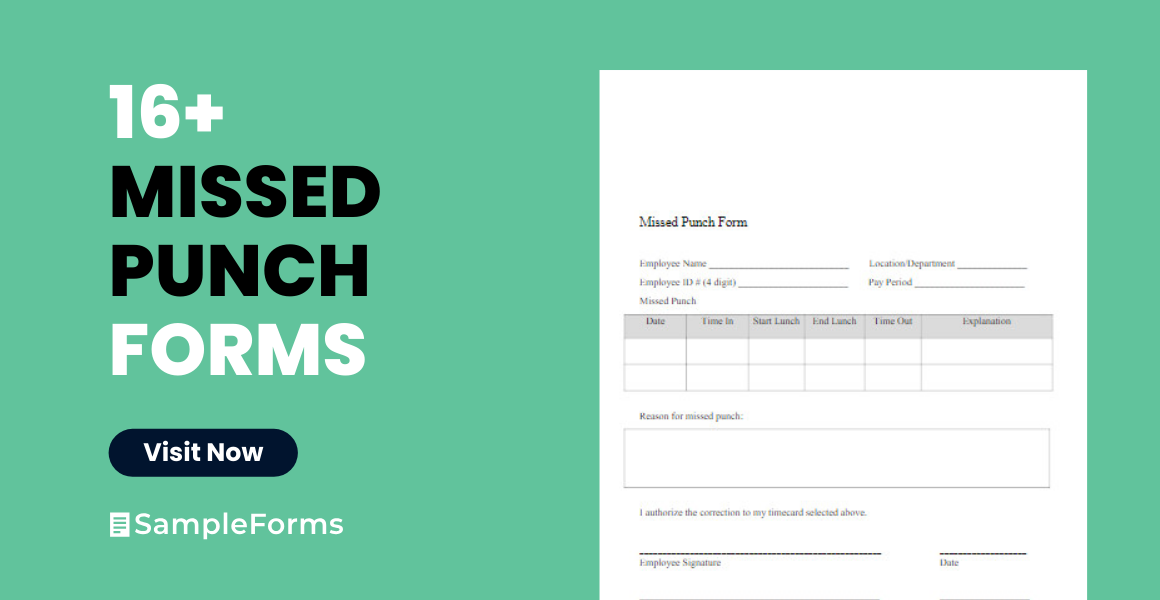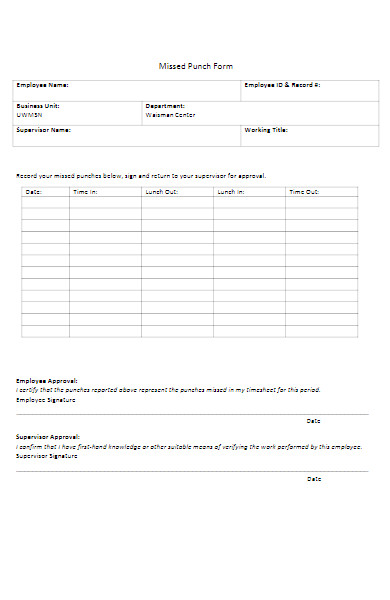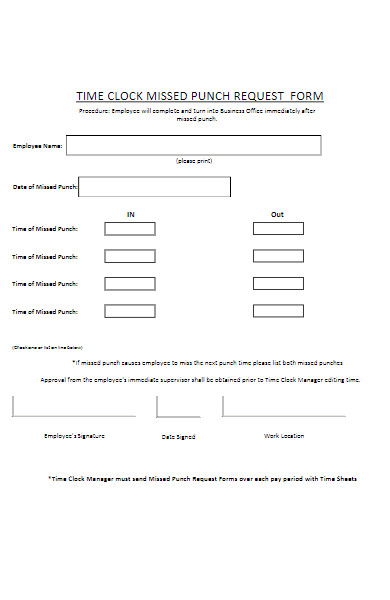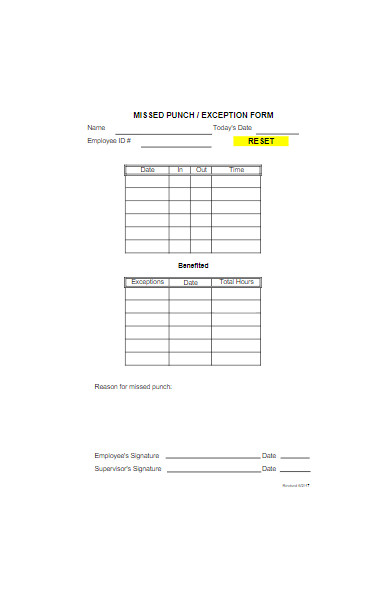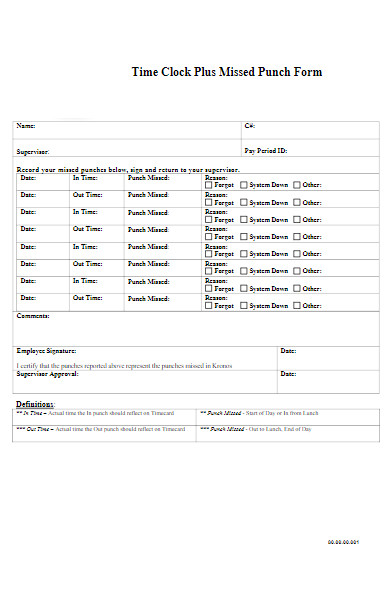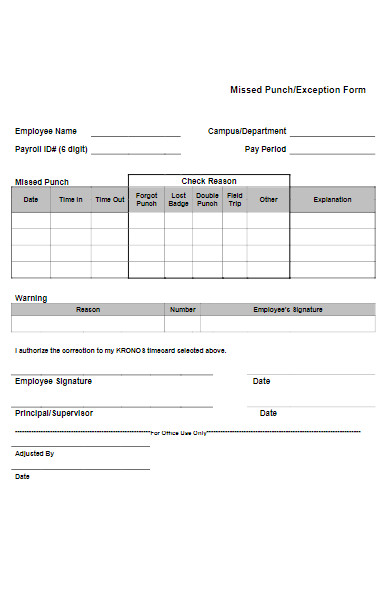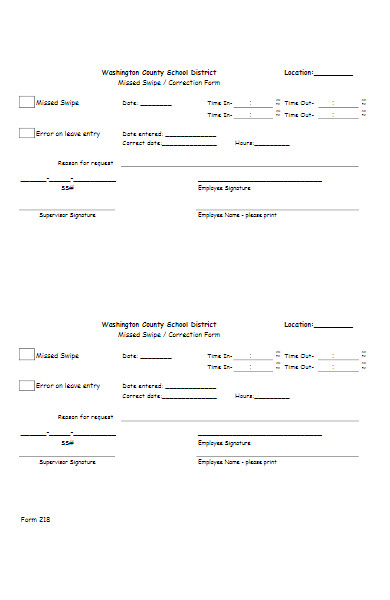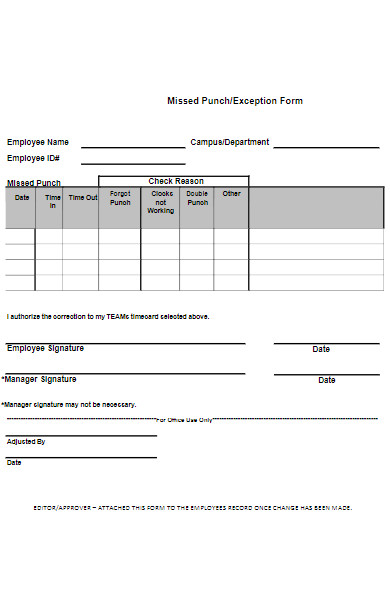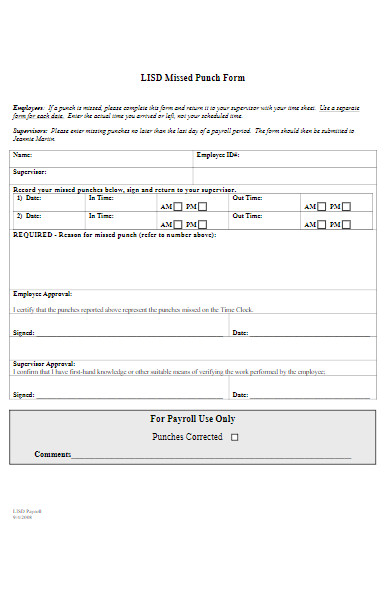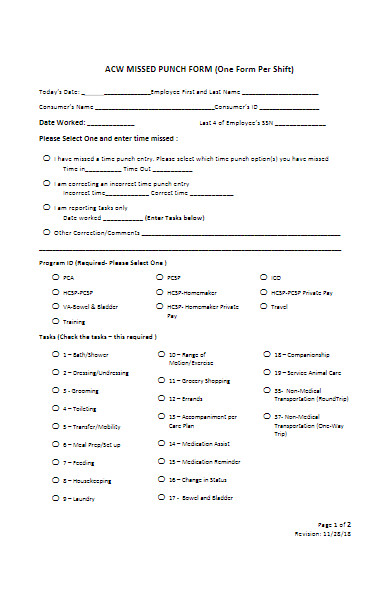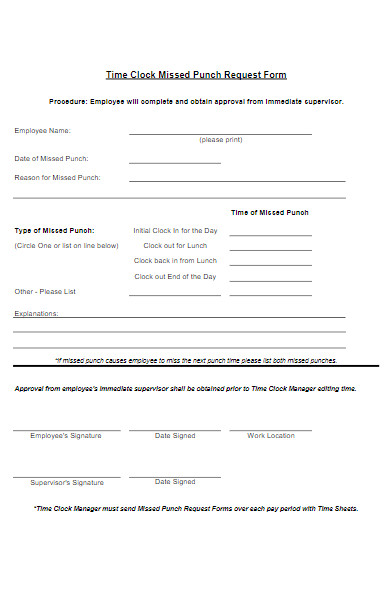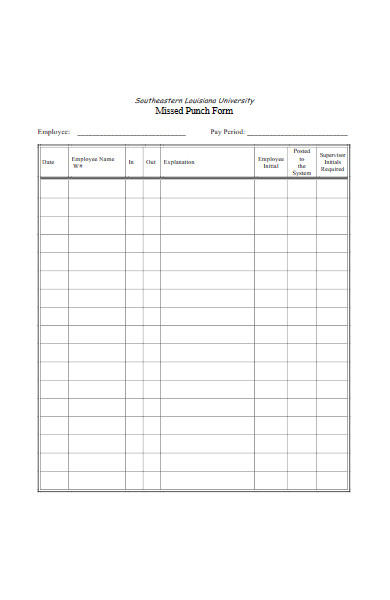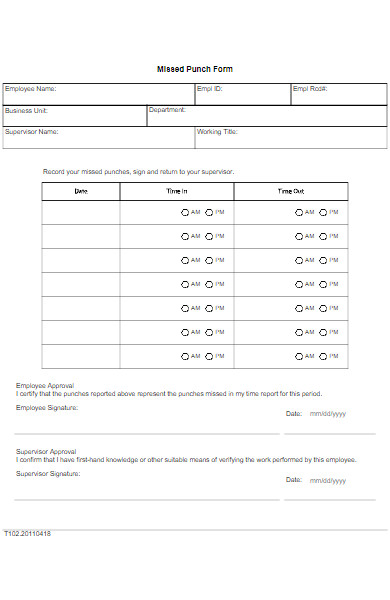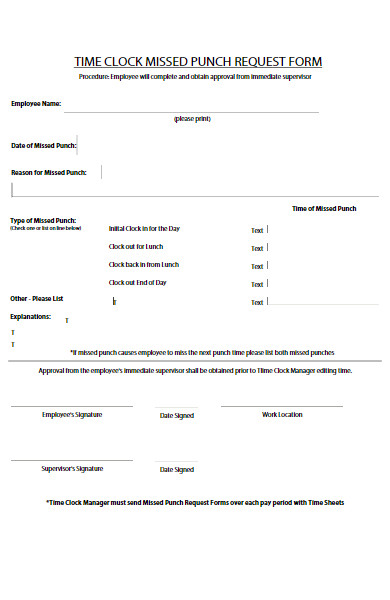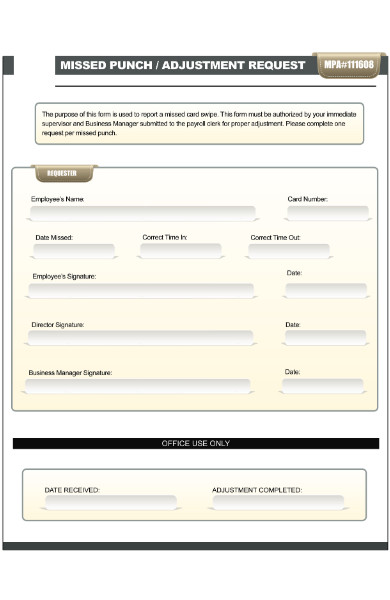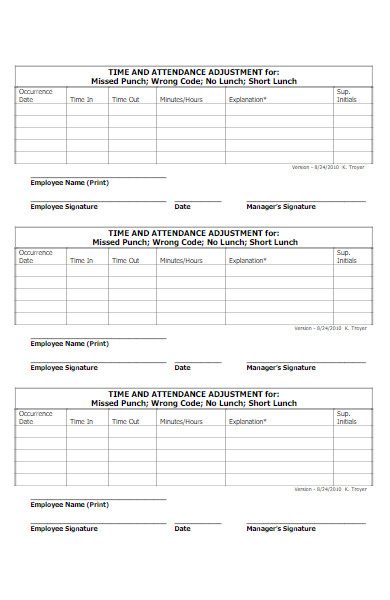Navigating the intricacies of workplace time-tracking, a Missed Punch Form emerges as a critical document. It serves as a rectification tool for employees who forget to clock in or out, ensuring accurate record-keeping. Delving deeper, we’ll explore the essence of these printable form, its varied types, illustrative examples, and a comprehensive guide to crafting one. Additionally, we’ll share valuable tips to refine its usability, reinforcing its importance in the realm of efficient time management at work.
What is a Missed Punch Form ? – Definition
A Missed Punch Form is a document used by employees to report instances when they failed to clock in or out using the standard time-tracking system of an organization. This form serves as a formal means of communication between the employee and the HR or payroll department, allowing for accurate adjustment of hours worked. It typically captures details such as the employee’s name, date of the missed punch, the intended clock-in or clock-out time, and a reason for the oversight. These fillable form ensures that employees are compensated correctly for the hours they’ve worked, even if they forget to register their attendance at the designated times.
What is the Meaning of a Missed Punch Form?
The meaning of a Missed Punch Form lies in its function as a corrective tool within an organization’s time and attendance system. When employees forget, or for some reason are unable to record their clock-in or clock-out times, this form provides a mechanism to rectify and officially report the oversight. By filling out a Missed Punch Form, employees communicate the accurate timings of their work shifts to the payroll or HR department, ensuring that they are compensated correctly. The form, therefore, acts as a safeguard against unintentional errors in timekeeping, promoting fairness and accuracy in the payment process.
What is the Best Sample Missed Punch Form?
A good Missed Punch Form is straightforward, captures all essential details, and is easy to process by the HR or payroll department. Below is a basic sample of a Missed Punch Form:
Employee Details:
- Full Name: ________________________________
- Employee ID: ______________________________
- Department: _______________________________
- Position: _________________________________
Missed Punch Details:
- Date of Missed Punch: //______
- Scheduled Start Time: : [AM/PM]
- Actual Start Time (if different): : [AM/PM]
- Scheduled End Time: : [AM/PM]
- Actual End Time (if different): : [AM/PM]
Reason for Missed Punch:
[ ] Forgot to clock in/out
[ ] Clock malfunctioned
[ ] Was working off-site
[ ] Emergency situation
[ ] Other: ___________________________________
Additional Comments (if any):
Employee Signature: ____________________________ Date: //______
Supervisor/Manager Verification: (To be filled by the supervisor or manager)
I verify the above information to be accurate and approve the adjustment.
Supervisor/Manager Name: ____________________________
Supervisor/Manager Signature: ____________________________ Date: //______
This is a basic template, and organizations can adapt or expand upon it based on their unique requirements, such as adding sections for multiple missed punches, specific company policies, or any additional verification processes.
FREE 16+ Missed Punch Forms in PDF
17. Formal Time Clock Missed Punch Request Form
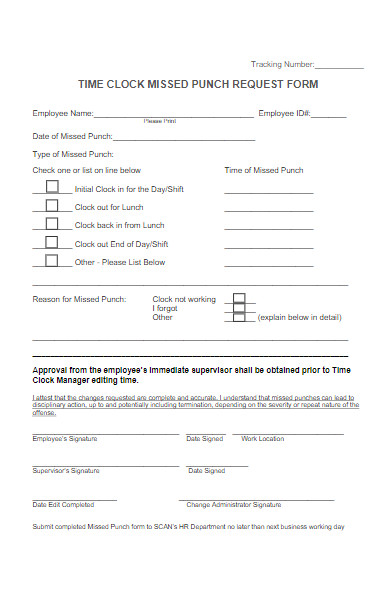
What is the primary purpose of a Missed Punch Form?
The primary purpose of a Missed Punch Form is to provide employees with a formal mechanism to report and rectify instances where they failed to clock in or out using the standard time-tracking system of an organization. This ensures:
- Accuracy in Record-Keeping: The form allows for an official record of the correct times an employee worked, even if they initially missed recording it.
- Fair Compensation: By accurately reporting their work hours, employees ensure they are compensated correctly for the time they’ve worked.
- Accountability and Transparency: The form requires both the employee and, in many cases, a supervisor or manager to verify the missed punch, ensuring there’s a transparent process and mutual accountability.
- Compliance with Labor Laws: Accurate timekeeping is crucial for compliance with labor regulations. The form aids organizations in adhering to these requirements by capturing accurate work hours.
In essence, the Missed Punch Form serves as a safeguard against unintentional timekeeping errors, ensuring that both the employer and employee have an accurate, verifiable record of hours worked.
How often can I submit a Missed Punch Form if I forget to clock in or out?
The frequency with which an employee can submit a Missed Punch Form varies depending on an organization’s policies and procedures. Generally:
- No Set Limit: Some organizations might not have a specific limit on how often an employee can submit a Missed Punch Form. However, repeated instances might raise concerns about the employee’s attentiveness or the functionality of the time-tracking system itself.
- Limited Occurrences: Some companies might set a limit on the number of allowable missed punches within a specific period (e.g., no more than three missed punches in a month). Exceeding this limit might result in disciplinary action.
- Progressive Disciplinary Action: Organizations with stricter timekeeping policies might implement a progressive disciplinary system. For instance, the first few missed punches could result in a verbal warning, followed by a written warning for subsequent offenses, and further infractions could lead to more severe consequences.
It’s essential for employees to familiarize themselves with their organization’s specific policies regarding missed punches and the associated consequences. Regularly forgetting to clock in or out could be perceived as negligence or carelessness, so it’s always a good practice for employees to be diligent about their timekeeping responsibilities. You should also take a look at our Training Forms.
Where can I find the official Missed Punch Form for our organization?
To locate the official Missed Punch Form for your organization, consider the following common avenues:
- Human Resources (HR) Department: The HR department typically manages timekeeping and payroll matters. They should have all the necessary forms, including the Missed Punch Form. You can directly approach them or check if they have a dedicated section on your company’s internal portal or website.
- Supervisor or Manager: Often, your immediate supervisor or manager will have access to these forms or can guide you to the right place or person.
- Company’s Intranet: Many organizations have an internal network or intranet where they store official documents, forms, and other resources for employees. There might be a ‘forms’ or ‘resources’ section where you can download the required document.
- Timekeeping System: If your organization uses electronic timekeeping or a Human Resource Management System (HRMS), the system might have a built-in feature for reporting missed punches or a digital version of the Missed Punch Form.
- Employee Handbook: The employee handbook or manual might have information on where to find the form or how to report a missed punch.
- Colleagues: Sometimes, your colleagues, especially those who’ve been with the company longer or have had to use the form themselves, can be a good resource.
- Notice Boards: In some organizations, essential forms are kept in physical folders or binders near notice boards, especially in areas like break rooms or near time clocks.
Remember, if you’re unsure, always start with your HR department, as they are typically the primary custodians of such forms and can guide you appropriately.
How quickly do I need to submit a Missed Punch Form after realizing my error?
The required timeframe for submitting a Missed Punch Form after realizing an error largely depends on an organization’s specific policies and procedures. However, general guidelines and practices include:
- As Soon As Possible: Most organizations prefer that employees submit the form as soon as they notice the missed punch to ensure timely and accurate payroll processing.
- Within the Current Pay Period: Some companies might have a policy that the form must be submitted within the same pay period in which the error occurred. This ensures that any corrections can be made before payroll is finalized.
- Set Timeframe: Certain organizations might have a specific timeframe, like 24 to 72 hours after the missed punch, within which the form must be submitted.
- Before Payroll Cut-off: It’s especially important to submit any corrections before the payroll cut-off date. Missing this deadline could result in an error in your pay, which might only be rectified in the subsequent pay period.
- Flexible Policies: Some organizations might have a more flexible approach, especially if missed punches are infrequent. However, prolonged delays can cause administrative challenges and might be frowned upon.
It’s essential to be familiar with your organization’s policies to avoid any complications or delays in pay. When in doubt, it’s always a good practice to address the error and submit the form as quickly as possible to ensure accurate record-keeping and timely compensation. Our workshop registration forms is also worth a look at
Who should I submit my completed Missed Punch Form to within the company?
The appropriate recipient of a completed Missed Punch Form can vary by organization, but generally, the following departments or individuals are common points of submission:
- Human Resources (HR) Department: In many organizations, HR handles matters related to timekeeping and payroll. Submitting your form to HR ensures it reaches the appropriate personnel who can process and address the missed punch.
- Payroll Department: If your organization has a separate payroll department distinct from HR, they might be the direct recipients of missed punch forms since they manage pay calculations.
- Immediate Supervisor or Manager: Some companies prefer that you first submit such forms to your immediate supervisor or manager for review and approval. Once they’ve signed off, the form might be forwarded to HR or payroll.
- Timekeeping or Attendance Office: Larger organizations, especially those with multiple shifts and departments, might have a dedicated office or team that handles daily attendance and timekeeping matters.
- Online Portal: With the advent of digital HR systems, some companies allow employees to submit corrections or forms electronically via an internal portal or system. In this case, once you upload or submit the form, it’s routed to the appropriate department or individual.
- Administrative Assistant or Office Manager: In smaller companies without a dedicated HR or payroll department, the office manager or administrative assistant might handle such tasks.
Whenever you’re in doubt about where to submit a form or document, it’s a good practice to consult your employee handbook or ask your immediate supervisor. They can guide you to ensure the form reaches the right hands in a timely manner. You can check our Declaration Forms.
Can I fill out a Missed Punch Form online, or is there a specific paper format required?
Whether you can fill out a Missed Punch Form online or if a specific paper format is required largely depends on your organization’s policies, practices, and the technology they employ. Here’s a breakdown of the possibilities:
- Online or Digital Platforms: Many modern companies, especially larger ones or those that prioritize digital transformation, utilize online Human Resource Management Systems (HRMS) or timekeeping systems. These platforms often have features that allow employees to submit missed punches or corrections electronically.
- Paper Format: Some organizations, especially smaller ones or those that have not yet transitioned to digital systems, might still rely on paper forms. In such cases, you would need to fill out a physical form and submit it to the relevant department or individual.
- Hybrid Approach: Certain companies might offer both options. They might have an online system but also accept paper forms, especially if there’s a technical glitch or for employees who aren’t comfortable with digital platforms.
- Email: If the organization does not have a dedicated online system but still prefers digital communication, they might allow employees to fill out a digital version of the form (like a PDF) and email it to the relevant department.
It’s essential to familiarize yourself with your company’s preferred method. Check the employee handbook, ask HR, or consult your supervisor to understand the correct and accepted procedure for submitting a Missed Punch Form in your organization.
Are there penalties or consequences for frequently needing a Missed Punch Form?
Yes, in many organizations, there can be penalties or consequences for frequently requiring a Missed Punch Form. Regularly forgetting to clock in or out can be seen as a sign of negligence or carelessness regarding one’s job responsibilities. Here’s a general overview of potential repercussions:
- Verbal or Written Warning: Repeated offenses might first result in a verbal warning from a supervisor or HR. If the behavior continues, it may escalate to a written warning documenting the frequency and dates of the missed punches.
- Impact on Performance Reviews: Habitual negligence in clocking in or out can be noted in employee performance reviews, reflecting negatively on an individual’s overall job performance or reliability.
- Payroll Delays: If you regularly forget to clock in or out, it might cause delays in receiving your correct pay, especially if the Missed Punch Form isn’t submitted promptly.
- Training or Counseling: Some organizations might require employees who frequently miss punches to attend time management or organizational training sessions. Alternatively, they might have to meet with HR for counseling about the importance of accurate timekeeping.
- Probation or Disciplinary Actions: In extreme cases, where the behavior continues despite multiple warnings, an employee might be placed on probation or face other disciplinary actions, which can include suspension.
- Loss of Trust: Regularly needing to adjust time records can result in a loss of trust from supervisors or management, which can affect opportunities for advancement or additional responsibilities.
- Termination: While it’s rare for missed punches alone to lead to termination, if it’s part of a broader pattern of neglecting job responsibilities or if it’s believed to be an attempt at time theft, it could lead to severe consequences, including job termination.
To avoid these potential repercussions, it’s essential to be diligent about clocking in and out. If you recognize a pattern where you’re often forgetting, consider setting reminders for yourself or placing a note in a visible location to help remember.
Who can I contact if I have questions or need clarification about filling out the Missed Punch Form?
If you have questions or require clarification about filling out the Missed Punch Form, the appropriate point of contact can vary based on the structure and policies of your organization. However, typically, the following are the most likely sources of assistance:
- Human Resources (HR) Department: HR is often the primary department overseeing timekeeping and related forms. They will be knowledgeable about the specifics of the form and can provide guidance on how to fill it out correctly.
- Immediate Supervisor or Manager: Your immediate supervisor or manager should be familiar with the process and can help answer questions or direct you to the appropriate department or individual for further assistance.
- Timekeeping or Attendance Office: If your organization has a dedicated office or department for timekeeping or attendance, they would be the experts on the form’s specifics.
- Colleagues or Coworkers: Sometimes, fellow employees who have previous experience with the form can provide practical insights or tips on filling it out.
- Employee Handbook: Many organizations include detailed guidelines about timekeeping and related forms in their employee handbooks. Reviewing this resource might provide clarity.
- Online Portal or Digital HR System Help Section: If your organization uses an online system for HR tasks, there might be a help section or FAQ that provides answers to common questions about the Missed Punch Form.
- Administrative Assistant or Office Manager: In smaller companies without a dedicated HR or timekeeping department, the office manager or administrative assistant might be knowledgeable about procedural aspects and can offer guidance.
When in doubt, it’s always a good idea to start by asking your immediate supervisor or checking with HR. They can either provide the answers you need or guide you to the appropriate person or department for assistance. In addition, you should review our Community Forms.
How to Create a Missed Punch Form?
Creating a Missed Punch Form involves identifying the crucial pieces of information that need to be captured to accurately adjust time records. Follow this step-by-step guide to design a comprehensive form for your organization:
-
Choose a Platform:
- Decide whether the form will be paper-based, digital (like a PDF), or available through an online system.
-
Title and Branding:
- At the top, title the document “Missed Punch Form” or a similar appropriate title.
- Add your company’s logo and branding elements for a professional touch.
-
Employee Details:
- Space for the employee’s full name.
- Employee ID or badge number.
- Department or team.
- Position or job title.
-
Missed Punch Details:
- Date of the missed punch.
- Original clock-in time (if any was recorded).
- Original clock-out time (if any was recorded).
- Corrected clock-in time.
- Corrected clock-out time.
-
Reason for Missed Punch:
- Provide space or a dropdown for employees to select or write the reason they missed the punch (e.g., forgot, system error, left badge at home).
-
Confirmation or Verification:
- Space for a supervisor or manager’s signature or initials to verify the change.
- A section for any notes or comments by the supervisor.
-
Submission Details:
- Instructions on how to submit the completed form (e.g., return to HR, submit to a manager).
- Any additional steps required post-submission (like logging into an online system to make a digital note).
-
Timestamp and Tracking:
- If digital, add a timestamp feature to record when the form is submitted.
- Consider a unique tracking or reference number for each form to monitor and manage them efficiently.
-
Contact Information:
- Include contact details for HR or the appropriate department for questions or clarifications regarding the form.
-
Instructions:
- Add clear step-by-step instructions on how to fill out the form correctly, especially if there are sections that might be confusing.
-
Privacy and Confidentiality:
- Note any privacy considerations, emphasizing that the information will be kept confidential and used only for timekeeping and payroll purposes.
-
Review and Feedback:
- Before finalizing, have several team members test the form. Gather feedback and make any necessary adjustments for clarity or functionality.
-
Distribution:
- Decide how you’ll distribute the form (e.g., available at HR, downloadable from an intranet site, through an online HR system).
-
Updates and Revisions:
- Periodically review and update the form as necessary to ensure it remains effective and in line with any changes in company policy or regulations.
By following this guide, you’ll have a comprehensive and functional Missed Punch Form tailored to your organization’s needs.
Tips for creating an Effective Missed Punch Form
Creating an effective Missed Punch Form ensures that your organization captures the necessary details while minimizing errors and confusion. Here are some tips to consider:
- Simplicity is Key: Make sure the form is straightforward and easy to understand. Avoid jargon or overly technical terms.
- Use Clear Labels: Every section should have a clear label indicating what information is required.
- Provide Examples: Offer example entries for sections that might be confusing to ensure that employees understand how to complete them.
- Group Related Fields: For instance, all time-related fields (original and corrected times) should be grouped together for clarity.
- Dropdown Menus: If the form is digital, use dropdown menus for common reasons for a missed punch to ensure consistency in responses.
- Include a Checklist: A brief checklist reminding employees to sign the form, verify all details, or attach any necessary documentation can be beneficial.
- Mandatory Fields: Highlight mandatory fields that must be filled in before the form is considered complete.
- Responsive Design: If the form is digital, ensure it’s mobile-friendly. Many employees may want to access or fill out the form via smartphones or tablets.
- Auto-Fill Options: For digital forms, incorporate auto-fill options for repetitive fields like the employee’s name or ID if they’re frequently using the form.
- Feedback Mechanism: Include a section or method for employees to provide feedback on the form itself, helping with continuous improvement.
- Version Control: If updates or changes are made to the form, keep track of versions to avoid confusion. Always ensure that employees are using the most recent version.
- Clarify Turnaround Time: Indicate how long the processing time typically is once the form has been submitted, so employees know when the correction will reflect in their records.
- Provide Contact Details: Clearly state who to contact if there are questions or issues while filling out the form.
- Privacy Measures: Ensure that there are measures in place to protect the privacy of the information being shared, especially if sensitive details are included.
- Regularly Review: Periodically review and refine the form based on feedback and any changes in company protocols.
- Training: Consider offering a brief training or guidance session for employees when the form is introduced, ensuring everyone understands its purpose and how to complete it.
Remember, the goal of the Missed Punch Form is to correct errors efficiently while ensuring accuracy and compliance. A well-designed form will streamline this process, making it easier for both employees and HR personnel.
A Missed Punch Form is an essential tool in the HR toolkit, facilitating accurate timekeeping and ensuring payroll precision. This document, available in various types, allows employees to correct clock-in/out errors, upholding accountability. Proper creation of this form is crucial, incorporating relevant details and ensuring user-friendliness. By following comprehensive guidelines and prioritizing efficiency, organizations can minimize time discrepancies and maintain a transparent work environment. You may also be interested in our membership registration forms.
Related Posts Here
-
FREE 10+ Human Resources Survey Forms Download – How to Create Guide, Tips
-
Two Weeks Notice Resignation Letter
-
HR Letter
-
Bio Data Form
-
Reference Check Form
-
FREE 50+ Leave of Absence Forms Download – How to Create Guide, Tips
-
FREE 50+ Job Request Forms Download – How to Create Guide, Tips
-
FREE 8+ Labor Application Forms in PDF
-
FREE 50+ Overtime Request Forms Download – How to Create Guide, Tips
-
FREE 20+ New Employee Details Forms Download – How to Create Guide, Tips
-
FREE 25+ Life Insurance Beneficiary Forms Download – How to Create Guide, Tips
-
FREE 5+ Request to Hire Forms in PDF | Excel
-
FREE 7+ Payroll Adjustment Forms in MS Word | PDF | Excel
-
FREE 10+ Pay Increase Forms Download – How to Create Guide, Tips
-
FREE 20+ Individual Evaluation Forms Download – How to Create Guide, Tips
